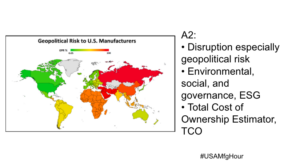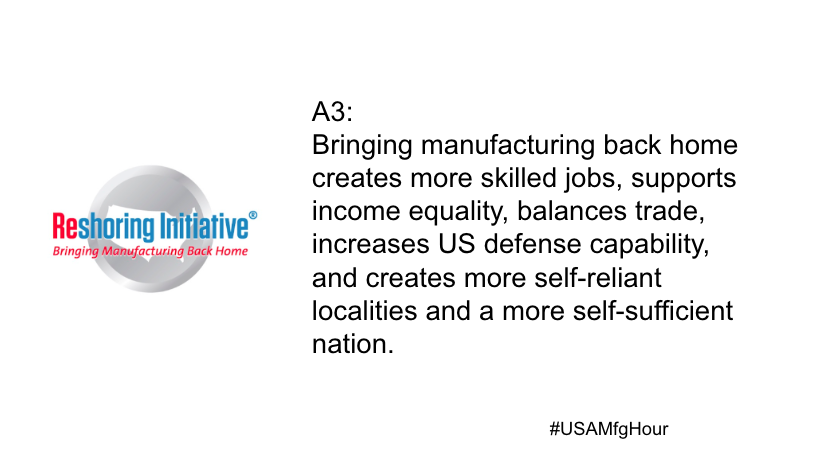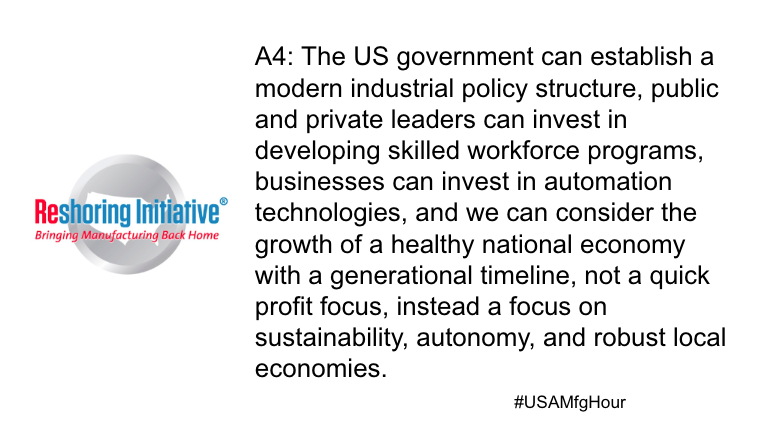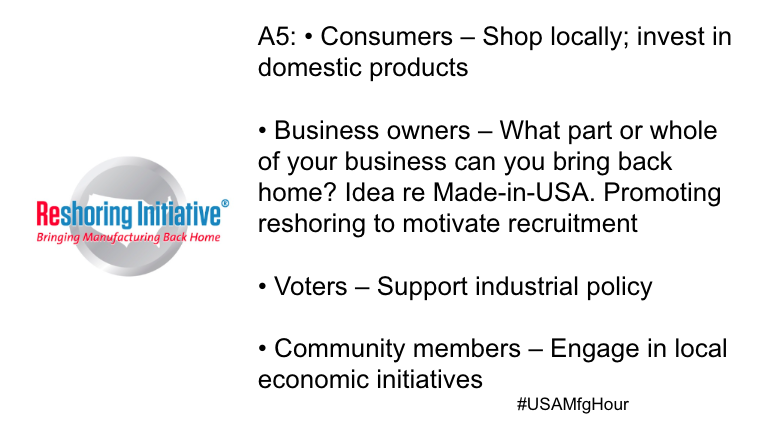2024 State of Reshoring: Trends, Indicators, Benefits, Responsibilities, Actions, Opportunities, and Resources
Updated: July 25, 2024
Published: July 17, 2024
In recent years, reshoring has become a crucial topic in the manufacturing industry, particularly in light of global disruptions like the COVID-19 pandemic. The movement to bring manufacturing back to domestic shores is gaining momentum, and industry experts weigh in on the current trends, factors and benefits associated with this shift.
In a recent #USAMfgHour chat on X, Harry Moser, Founder and President of the non-profit Reshoring Initiative, led participants in a discussion on the state of reshoring, foreign direct investment (FDI), nearshoring and domestic manufacturing efforts.
Current Trends in Reshoring and Domestic Manufacturing Efforts
The conversation began with an exploration of the current trends in reshoring, FDI, nearshoring, and domestic manufacturing efforts. Host Moser asked participants to share the trends they have seen.
“I just know it’s been a hot topic ever since the start of the COVID-19 pandemic,” commented Whitney Koch of Keystone Click. “I’m interested to hear if there’s been any action taken since.”
Nigel Packer of PelaTis Online is from Wales and offered his outside perspective.
“I cannot speak for the USA. My observations in the UK have shown a big increase in the reshoring. This has led to [the] UK going up in the world export tables from 7th to 4th. Naturally our MSM [mainstream media] do not consider this as news and have ignored it,” he said.
Jim Palmer of BuyDirectUSA, an online directory and promoter of American-made products, shared a broader perspective of what he sees happening in manufacturing.
“Instead of companies returning [their manufacturing to America] I see more smaller ones [companies] already here stepping up, scaling or starting. Then we have China getting tax dollars to manufacture in the USA,” he said.
Responding to Palmer, host Moser described the impact of reshoring on smaller companies compared to larger ones.
“Big companies get the attention. For every job reshored at a big company there are 2 or 3 at supplier companies,” he said.
“We work with a lot of manufacturers and distributors. Many of them are having their buyers seek out local North American Sources for supplies,” answered Kirsten Austin of DCSC, Inc. “Let’s just say they had to wait a long time during the Covid Situation Time Period. Looking locally is a good idea and making more solid relationships here in the USA can help.”
Tracy St. Clair of Integrated Logistics Services responded to Austin’s comment, adding, “I agree with you on this. Local connections is (sic) so important.”
“… and cheaper is not better if it’s sitting in a port for weeks and holding back your orders,” Austin replied to St. Clair.
Adding to the comment thread, host Moser shared an interesting statistic.
“Survey says that 80% of companies are reshoring or planning reshoring, up from 10% in 2012,” said Moser.
Anna and Susannah Scheller of Capri Temporary Housing expressed their feelings about that number.
“It’s a huge jump!” they exclaimed. “And one that we’re grateful to hear about because it’s far more stable.”
Responding to the Schellers, Ruby Rusine of Social Success Marketing commented, “Def (sic) not an expert but I think we are seeing the negative impact of off-shoring.”
As a reply to host Moser’s original question, the Schellers asked a question themselves.
“We haven’t honestly paid the closest attention to it recently, but know it’s been a major discussion point since the supply shortages started a few years back,” they said. “Has nearshoring and DM transformed the supply chain issues at all?”

To conclude this portion of the chat, host Moser included the above chart showing the increase in American jobs as related to reshoring and foreign direct investment (FDI) from 2010 to 2023. It’s worth noting that in 2022 and 2023, reshoring and FDI job announcements were the highest on record since 2010 and that the percentage of companies reshoring has jumped from 8% to 70% since 2012.
Upon seeing these stats, Koch exclaimed, “Wow! 8% to 70% is quite a jump!”
“Just what we were thinking!” the Schellers replied to Koch. “And it’s a good thing too, hopefully it’ll stave off supply chain issues in the future.”
Factors Amplifying the Need for Domestic Manufacturing
The pandemic exposed vulnerabilities in global supply chains, leading to a greater emphasis on local production. Participants were then asked what factors amplified the need for reinvesting in domestic manufacturing.
“American companies don’t want to rely so heavily on foreign manufacturing partners because they’ve experienced how world events can create major problems and prevent them from delivering on time,” asserted Koch.
“Not sure but I think what happened during that time was a rude awakening – factories shutting down, labor shortage, supply chain issues..it was a domino effect,” speculated Rusine.
Starting a side conversation, host Moser replied to Rusine, “Even some noted economists are starting to realize that their models were wrong. The offshoring cost us more in jobs than it saved in low prices.”
“Absolutely,” Rusine concurred with host Moser. “And to add to that….this extends to the detrimental practice of discarding short-lived, poorly-made products in overflowing landfills. I digressed but it is what it is.”
“The annual world loss due to overstocking and disposal is about $180 Billion,” stated host Moser. “Plus the excess sitting in closets and rarely worn. If you feel a need to buy something/anything, find something Made in USA to buy!”
“180B USD? That. Is. Insanity,” asserted Rusine.
“Ruby, [b]uy quality and look after it,” chimed in Packer. “I have clothes that are 40 years old and am still wearing them. They have been in and out of fashion many times. I’m often the most trendy.”
“This!” the Schellers emphatically agreed with Packer. “And go thrifting where possible for personal items. Thrifting is a great way to make sure items are used to their fullest capability and keep things out of the landfills.”
“I am a very active Buy Nothing member,” stated Rusine. “We love saving stuff from the landfill. We have also partnered with our CSD [Center for Sustainable Development] during our community clean-up day to save some items from the dump – so we corral them and give them back to our members that could use it (sic). We couldn’t save all but we saved some.”
To answer host Moser’s question, the Schellers responded with their top reason for reinvesting in domestic manufacturing.
“Without even going into the time + energy costs for international supply or the supply chain issues that can be caused, going local/domestic with manufacturing and supply creates better assurance in your own product and stability,” they said.
Host Moser commended their response.
“Great points,” he said. “Reshoring helps with climate, income equality, defense industry capability, federal budget and more.”
“The biggest factor I see is the creation of manufacturing lines that reduce the number of people required on the production line,” commented Packer. “By innovating with robots and machinery we can reduce the reliance on low-skilled labour, it will increase productivity and profits.”

Before transitioning to the next question, host Moser tweeted the above graphic depicting the countries of the world and where they are on the spectrum of geopolitical risk to America. Because outsourcing to foreign countries carries its own risks, manufacturing leaders can reap the benefits of improving their environmental, social, and governance (ESG) score and total cost of ownership by reshoring their operations.
Benefits of Reshoring for the Nation
Aside from reducing geopolitical risks, there are other national benefits to reshoring. Host Moser prompted participants to share how bringing manufacturing operations back to the United States could benefit the entire country.
“It would help the American economy by creating more jobs,” asserted Koch.
“USA benefits by adding more jobs, stimulating our own economy, controlling crisis situations better, encouraging the entrepreneurial spirit, providing more freedoms, and creating more businesses,” declared Austin.
“I love this question,” enthused Rusine. “We could have a chat dedicated for this question.
-jobs, jobs, jobs
-manufacturing strength
-innovation
-supply chain security (we experienced insecurity not too long ago)
– and more.”
“And a strong enough economy to take care of us when we are all my age!” host Moser replied emphatically.
Packer added an extensive list of benefits to the conversation.
“Export revenues. Low unemployment numbers. Happier citizens. Realisation of dreams for small/family manufacturers. Wealth creation,” he remarked.
#USAMfgHour chat regular Amy Anderson also had a long list to share:
“The nation benefits from reshoring :
– increased jobs
– better control of technology
– less transportation costs/risks
– more possibilities of innovation and research especially improved processes and offshoot applications.”
“Oh so many ways!” the Schellers proclaimed. “Economic stimulation, greater stability in supply chain, greater assurance of product quality… There’s lots!”
Though her list of benefits overlapped with the Schellers’ and Anderson’s, St. Clair was able to add some that others overlooked.
“To name a few: The creation of jobs, supply chain control, economic growth, reduced carbon footprint 👣 and many more benefits,” St. Clair said.

Host Moser’s final answer echoed participants’ responses. Reshoring benefits America by creating more skilled jobs, supporting income equality, balancing trade, and increasing national defense capability, all of which help localities and the country be more self-sufficient.
Synchronizing Responsibilities and Efforts
Creating a thriving domestic manufacturing landscape requires coordinated efforts and shared responsibilities among various stakeholders. Host Moser asked participants to share recommendations for how stakeholders can synchronize their work to make this happen.
“There are certainly many layers to this,” answered Koch. “I think there needs to be a push from national manufacturing organizations for collaboration and more government policies promoting restoring.”
In response to Koch, host Moser pointed out the role cost plays in reshoring efforts.
“The best policies would be to level the mfg. cost playing field > Skilled workforce like Germany and a 20% lower USD,” he said.
“It has to start with ideation and people recognizing how important it is to do such a thing, then the efforts to actually do so can begin,” asserted the Schellers. “It seems like a lot of people woke up to the need for it during 2020 and 2021.”
Affirming the Schellers’ assertion, host Moser added other geopolitical risks that have cropped up since the pandemic.
“Good point. COVID plus Suez and Ukraine have shown that risk is real,” he stated. “The biggest risk is now Taiwan/China. See our geopolitical risk map.”
“Ask the Government to get out of the way,” declared Packer.
“I would rephrase that,” host Moser replied to Packer. “Ask the government to level the playing field so we can push smoothly forward.”
“We may need to start re-educating our people – grassroots – because that is where the money’s from on why we should support U.S. companies and Made In USA initiatives,” added Rusine.

In addition to the responsibilities and efforts outlined by the chat participants, host Moser emphasized the big-picture view required to successfully reshore manufacturing.
“The US government can establish a modern industrial policy structure, public and private leaders can invest in developing skilled workforce programs, businesses can invest in automation technologies, and we can consider the growth of a healthy national economy with a generational timeline, not a quick profit focus, instead a focus on sustainability, autonomy, and robust local economies,” he said.
Host Moser’s closing answer elicited strong confirming responses from some chat participants.
“Thinking long term instead of today’s profit margin is major!” stressed Anderson.
Agreeing with Anderson, host Moser added: “Think workforce development, automation investment, product innovation. U.S. is much too short-sighted.”
“Long-term is the way to go with thinking, but it’s gonna take a while for us to get to where everyone recognizes its importance: we’ve been in an ‘instant’ society for so long that many people, C-suite executives included, forget how long great investments can take,” the Schellers opined.
“My two cents: The gov is a behemoth laden with other concerns,” Rusine noted. “This effort should start at the grassroot level. We are the people. We have @ReshoreNow and there’s @BuyDirectUSA. I would love to see more of that. If you are one of those, tag yourself here. We wanted to ‘see’ you.”
Advocating for a Self-Sufficient Economy
Advocating for a self-sufficient economy involves both individual and collective actions and is a bipartisan effort. The question is: How can we advocate for the self-sufficient economy our country needs?
“Conscious shopping and personal advocation in platforms like social media are the really big ones here,” commented the Schellers. “The greater profit/growth companies see in going local/domestic, the more likely they are to invest in local/domestic manufacturing.”
“Call your representatives – local, state, and federal!” proclaimed Koch. “If you communicate the importance of the issue, they *should* act on the will of their constituents. If they don’t, vote them out the next cycle!”

In addition to the chat participants’ recommendations that emphasized the role of the individual as a consumer, voter and community member, host Moser put the onus on business owners. He challenged them to consider what part of their business they could bring back to the United States.
Opportunities to Support Local Manufacturing
Reshoring and creating a robust domestic economy is important to all of us. There are numerous opportunities for both consumers and manufacturers to support local manufacturing efforts. Next, host Moser asked participants to name opportunities to support American manufacturing at the local and national level.
“Great question!” commended Koch. “As a consumer, research your area to discover which local manufacturers you can support with your business. Manufacturers in turn should participate more in local events to bring greater visibility.”
Koch’s response prompted replies from host Moser and Rusine.
“I suggest consumers ask their retailers what they offer Made in USA. If enough of us do that, they will offer more,” host Moser asserted.
“I’ve noticed a growing online movement urging Amazon to disclose the country of origin for products (‘Made in USA’ labeling). This is a positive step towards greater transparency for consumers,” shared Rusine.
“Awareness,” pronounced Anderson. “Educating regarding the positive impacts of manufacturing to offset negative preconceptions matters!”
“We are writing an article about the 5 Ss replacing the 3Ds: dark, dirty and dangerous,” host Moser commented in response to Anderson.
Conclusion
The state of reshoring and domestic manufacturing is evolving, with significant trends, benefits and opportunities emerging in recent years. By understanding the factors driving this movement and taking collective action, we can build a resilient and self-sufficient manufacturing landscape. Supporting local manufacturers, advocating for policy changes, and fostering innovation are essential steps toward a thriving domestic economy.
For more information and resources on reshoring, you can consult the free Total Cost of Ownership Estimator provided by the Reshoring Initiative. Together, we can contribute to a robust and sustainable manufacturing future.
About #USAMfgHour
Anyone who champions U.S. manufacturing can join in on a new conversation each week on Twitter using the hashtag #USAMfgHour. The chat starts at 11 a.m. Pacific Standard Time/2 p.m. Eastern. Share positive blog posts, helpful articles, news, important information, accomplishments, events, and more with other manufacturers and supporters from throughout the country.
Are you interested in hosting a #USAMfgHour chat? Contact organizers @DCSCinc, @SocialSMktg, and @KeystoneClick.
To learn more about how Keystone Click can help you level up your online presence, contact us.